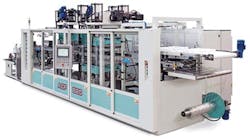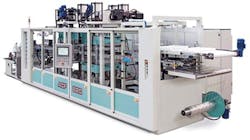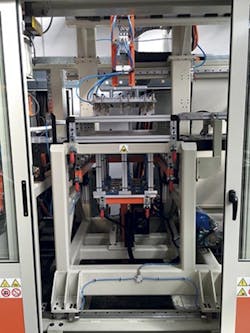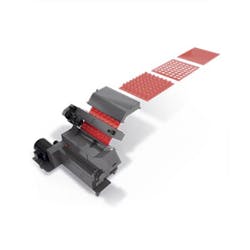Hurricane Irma derailed plans for a conference scheduled last month by the SPE Thermoforming Division, but machinery makers are moving forward with improvements to machines that make products such as trays, plates and lids. Companies that planned to participate at the Thermoforming Division's annual conference in Orlando, Fla., have announced upgrades and new equipment that advance the entire process — from machines that teach students about the art to equipment that speeds cycle times and assists in recycling scrap. The innovations take aim at boosting productivity, reducing costs and making the equipment easier to use.
Amut North America
Amut North America recently announced improvements to its thermoforming and robotic equipment.
In July, Amut installed a thermoforming system for a customer in Toronto that includes the company's FFG 980 thermoforming machine and a new, built-in ER3X robot. Also, two new Amut robots — the ER2X and the ER3X — recently became available in North America after making their debuts at the K show last year in Düsseldorf, Germany.
The robots are designed to work with Amut's high-speed thermoforming machines — the FFG and the new ACF series. The robots represent a major advancement in the company's technology, said Anthony Georges, president of Amut North America. "We [previously] offered robots, but with simpler technology," he said. "They were just pick-and-place devices. With the new robot, it is a programmable system."
The new robots can be programmed with instructions for handling specific parts. When production on a particular part begins, the operator can enter a code or part number so that the thermoforming machine and robot are programmed. In this way, the robot knows how to remove and stack the parts.
"It allows for much faster set-up times," Georges said. "You don't have to do any settings changes. It is fast-learning technology."
Amut's new Easy software coordinates the robot's operations with that of the thermoforming machine. This also allows for higher-speed operations.
The ER2X is the simpler of the two robots. It consists of a vertical axis to pick up and discharge thermoformed parts and one horizontal axis to take the parts from the picking station to the stacking area.
The ER3X is equipped with vertical and horizontal axes, but it also has a third rotating axis that allows for a part to be rotated by as much as 180 degrees for stacking.
Amut will be installing its first ACF-series thermoforming machine in North America at a different Toronto plant this November. The ACF series was introduced at last year's K show, but only now is coming into the American and Canadian markets.
Amut demonstrated the ACF 820 model, which is configured with three stations — for forming, cutting and stacking — at both the K show and Chinaplas this year in Shanghai. One of three sizes available, the ACF 820 has a forming size of 820mm by 650mm and a clamping force of about 27 tons. The cutting station has an area of 800mm by 630mm and clamping force of about 67 tons. The largest version is the ACF 980 with a 980mm-by-80mm mold size and a clamping force of about 45 tons. The smallest version is the ACF 600 with a 600mm-by-450mm mold size and a clamping force of about 22 tons.
The new ACF-series machines advance existing FFG-series technology. The software controlling the ACF series is one of the big differences.
"The interfacing of the technology goes directly to the terminal in the production control rooms," Georges said. "The president or production supervisor can see what is going on with the machine."
If there is a malfunction, plant supervisors can determine the problem remotely. In addition, if the machine is operating at less than full efficiency, they can see that and diagnose the reason.
"It's much more advanced software," he said. "With the technology, the person does not have to be in that building, but they can see what part is being made in real time and see the production rate. If a machine has stopped running, they can see why."
The ACF also is a faster-running machine than a comparable FFG model. The ACF has a new heating oven that permits the processing of much thicker PP sheets without the need for a preheater. In-mold labeling systems are optional.
In addition, with the ACF series, the molds can have built-in air and water connections that allow for faster changeovers, Georges said.
The ACF series comes in four configurations. The AC is a base model with one station that performs forming and cutting. The ACF-FF series has two stations: one for in-mold forming and cutting and one for stacking. The ACF series has three stations: one for forming, one for cutting and one for stacking. And the ACF-P series features four stations: one for forming, one for punching, one for cutting and one for stacking.
"It is a modular station that allows for much more flexibility in design and meeting customers' short-term and long-term requirements," Georges said.
The ACF series can handle a range of materials, including PET, HIPS, PS, EPS, PP, PLA and PVC, to produce items such as trays, lids, fruit and vegetable boxes, flowerpots, clamshells, nursery trays and plates.
In addition to marketing the new machines, in recent months Amut has increased the production speed by about 15 percent for its Compact series of inline extrusion and thermoforming equipment. The inline equipment pairs an AMP thermoforming machine with an EA130 single-screw extruder, Georges said.
Zed Industries
Zed Industries recently redesigned its Model L educational vacuum former and plans to release an updated Model L-3 next year.
The latest improvement to the Model L, introduced within the past 12 months, was the introduction of a dual-chamber vacuum system that allows for the production of both positive pressure and a vacuum with the same pump, said Peter Zelnick, CEO of Zed Industries. It eliminates a need in some instances to add a compressed air line to operate the machine when working with deep-draw or heavy molds.
The Model L is a portable, self-contained, tabletop demonstration and prototype vacuum former.
"It is unique in the fact [that] it only requires 110-volt power and can be run in a classroom from standard wall outlets," Zelnick said.
However, in previous models, a downside to the small size and limited power requirement was the potential for a loss of vacuum.
"In the old machine, if you had just a regular vacuum running off 110 [volts] without an airline, if you pierced a very heavy film or if you were using a lot of vacuum on a deep draw, you could lose vacuum and the platen would start to fall down," Zelnick said. "This design has been modified so that doesn't happen. You have two different chambers, a pressure and a vacuum chamber, and as a result, there is no loss of function on either side."
The Model L has an onboard form vacuum and compressor system for platen movement. The form size is a maximum of 14 inches by 15 inches and up to 4 inches deep.
The addition of the dual-chamber system was achieved without increasing the machine's power requirements.
"You can take it into your living room and plug it in and run it," Zelnick said. "This machine allows the student to view the heating and forming process. Operators can actually feel the film and apply vacuum manually."
Prices for the machine start at less than $10,000, Zelnick said.
Meanwhile, the company is working on optional upgrades to its Zed Model L-3, with modifications still under design.
"I haven't even built it yet," Zelnick said. "It's in design. It's that new."
It will be a dual-head machine built on one frame, Zelnick said. While it will be available to other customers, the redesigned L-3 is being developed for a customer working with crystallizable PET and other similar resins that must be heated to 500 degrees Fahrenheit to crystallize and cure in the mold to prevent shape distortion. The process could be used for applications in the food industry, including food trays.
Because of the precision required for manufacturing the parts that Zed's client makes, the new machine will be equipped with a supply of atmosphere-controlled pressurized air, which the L-3 previously didn't offer.
"We're now pressurizing the air," Zelnick said. "We're holding the pressurized air at 500-600 degrees," Zelnick said. "We can control the exact temperature in the [form] box, and we're doing it in dual-clamp frames that are oscillating. They work independently. You're running Job 1 while you're curing Job 2."
The cycle time on the existing L-3 model is 2 to 3 minutes. The company hopes to cut that time in half or better.
"I know for sure I can do half because we'll have two clamp frames," he said. "But we believe with our pressurized vacuum and pressurized cure heat we'll actually be able to shave another 20 to 30 percent off the cycle. That's a big change."
Cumberland
Cumberland in September introduced two new feed-roll systems — the Versatile FRV and the Edge Trim FRE series. Both are designed for thermoforming scrap reclamation.
"The Versatile FRV is larger," said Tyler Check, Cumberland's size-reduction project manager. "The Versatile has a 5-inch diameter roll. The Edge Trim [FRE] has a 3-inch diameter roll. The Versatile series can do anything from web sheet to formed sheet, whereas the Edge series is for thin strands of sheet and web, but not formed sheet."
Both series of feed rolls are used in combination with a granulator to process scrap sheet and film and reuse it in the thermoforming process.
The Versatile FRV series includes four models with roll widths ranging from 36 inches to 56 inches. The Versatile feed rolls come in two versions, providing the flexibility to run thin film or large-draw parts.
Product enhancements include:
• Self-adjusting strippers, which are easy to set up and prevent film from wrapping around the rollers. The plastic strippers, unlike traditional metal strippers, do not require manual adjustments, according to the company. The design also includes replaceable stripper blades to ease maintenance.• A robust drive design that includes a 3-horsepower C-frame motor drive for a top speed of 125 feet per minute for fast scrap processing. The drive system can reverse the feed-roll direction to clear jammed scrap without damaging the system.• Standardized feed rolls made from carbon steel with knurled surfaces for gripping smooth sheet. The interchangeable feed roll design is cost-effective, according to the company.• Air cylinders with built-in adjusters that allow users to set the minimum roll gap. A dial at the end of a pneumatic cylinder allows easy adjustment instead of the more traditional system of adjusting screws on the feed rolls to set the gap.
Cumberland's smaller Edge Trim FRE-series feed rolls are used in combination with a granulator to process narrow strips of sheet. They can be used inline or offline from the thermoforming process. Multiple feed-roll assemblies can be used with a single granulator if a process requires more than one Edge Trim FRE feed roll. The Edge Trim is available in two models with widths of either 6 inches or 10 inches.
Davis-Standard
Davis-Standard in recent months has expanded its line of high-speed extruders to include less-expensive models with optional gearboxes.
The company has offered a line of high-speed extruders, known as HSEs, primarily for producing flat sheet used in PP and high-impact PS thermoforming, said Steven DeAngelis, VP, sheet and foam systems for Davis-Standard.
The original HSE models featured direct-drive systems with an AC or permanent magnet synchronous motor. The direct-drive system maximized energy efficiency, allowing the extruders to use as few kilowatts as possible. The permanent magnet synchronous motor configuration offered energy savings of 10 to 15 percent when compared to traditional systems, according to the company.
However, Davis-Standard has introduced HSE models with optional gearboxes that offer the same high-speed performance but lower the cost of the systems by allowing customers to use standard AC motors.
"We have revamped it to be more commercialized, and we reintroduced the gearbox, which results in a little bit of an increase in energy usage, but the benefits are the use of more standard, off-the-shelf industrial components," DeAngelis said.
"Standard AC motors are easier to fix and easier and less expensive to replace," he said.
The HSE extruders are available in 50-, 65- and 75mm-diameter sizes.
The high-speed extruder is designed to produce sheet that can be cooled on a roll stand and fed to a thermoformer.
Bruce Geiselman, senior staff reporter
For more information
Amut North America,Vaughan, Ontario, 905-761-9400, www.amutgroup.com
Cumberland,New Berlin, Wis., 262-641-8600, www.cumberland-plastics.com
Davis-Standard LLC,Pawcatuck, Conn., 860-599-1010, www.davis-standard.com
Zed Industries Inc.,Vandalia, Ohio, 937-667-8407, www.zedindustries.com
About the Author
Bruce Geiselman
Senior Staff Reporter Bruce Geiselman covers extrusion, blow molding, additive manufacturing, automation and end markets including automotive and packaging. He also writes features, including In Other Words and Problem Solved, for Plastics Machinery & Manufacturing, Plastics Recycling and The Journal of Blow Molding. He has extensive experience in daily and magazine journalism.




